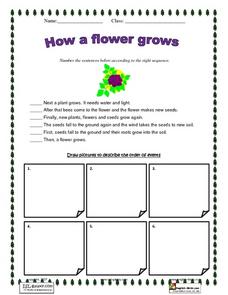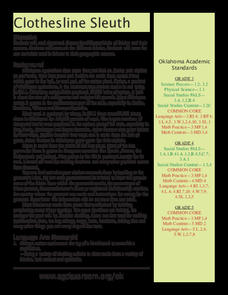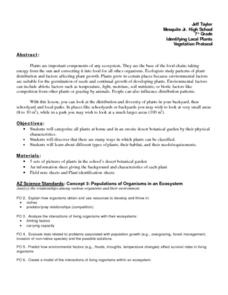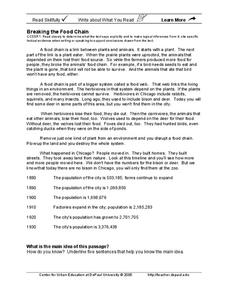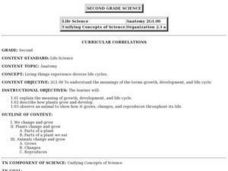Curated OER
Simple Genetics Practice Problems
Geneticists of the future identify heterozygous and homozygous genotypes, describe phenotypes, and use Punnett squares to solve problems and determine characteristics of offspring. A total of 15 questions make this a compact quiz or...
Curated OER
Corn Harvest
Learners read Corn Belt Harvest and write sentences about corn's uses. They visit a cornfield and a grain elevator or have guest speakers come to class. They design posters about harvesting or processing corn into grain.
Curated OER
Red Leaf, Yellow Leaf
Pupils discuss the differences between a storybook and an information book. Students use various materials found in nature to make a nature collage. Pupils make a nature dictionary using pictures and their own definitions from the...
Curated OER
Making Pretzels
Students explore how people use plants for food. They use pretzels to see how wheat can be turned into food.
Curated OER
Variations in Growth and Reproduction of Recently Transplanted Prairie Forbes and Grasses
students recognize and name prairie plants without the use of a key. they determine that prairie plants have different life cycles that affect their rate of growth and reproduction
Curated OER
How a Flower Grows
English Language Learners demonstrate their ability to sequence the steps in a process. After reading six sentences that describe how a flower grows, learners identify the right sequence and illustrate the steps. An answer key is provided.
Curated OER
Bats, Bees, Birds, and Blossoms
Youngsters use a paper bee to pollinate two paper flowers. They use hole-punch dots as pollen. Older learners dissect flowers and name the structures involved in pollination. The handouts mentioned in the lesson plan are not included, so...
Curated OER
Clothesline Sleuth
What fabrics are our clothes made of? Where do those fabrics from? Lead your pupils to discover the answers to these questions and more. Class members have a chance to play with various fabrics, invesitgating the materials and...
Curated OER
Grade Three Science Practice
In this grade 3 science worksheet, 3rd graders complete a set of 25 multiple choice questions related to a variety of 3rd grade science concepts. An answer key is included.
Curated OER
Chicka Chicka Boom Boom Tree
Students practice recognizing the letters in the alphabet. They create leaves of coconut trees out of cans and use magnetic letters to retell a story they heard before.
Curated OER
Prairie Find Outdoors
Students take a field trip to a local prairie. Using identification books, they identify various forbs and grasses in the prairie. As a class, they discuss the importance of forbs and grasses to the ecosystem and review the various types...
Curated OER
U.S. History: Antebellum Heroes and Villains
Eighth graders research and write reports on key figures of the Antebellum Period. The projects also include pictures, bibliographies, and timelines about their assigned figure. In addition, 8th graders present oral reports to classmates.
DePaul University
Breaking the Food Chain
Throughout history, the growth of big cities has resulted in the destruction of ecosystems. In the case of Chicago, IL, a grassland that was once home to bison, deer, wolves, and foxes quickly became a booming city of over three million...
Curated OER
What is Life? Demonstrations & Discussion
Display seven items for your biologists to consider. Are they living or non-living? How can you tell? This is a simple outline of what you can display and questions that can be discussed as this topic is explored. One way to use this...
Curated OER
Living Things Experience Diverse Life Cycles
Second graders will study and explain the meaning of growth, development, and life cycle. They describe how plants grow and develop and observe an animal to show how it grows, changes, and reproduces throughout its life.
Curated OER
Plants and Animals Crossword Puzzle
In this science activity, middle schoolers look for the answers to the questions to fill in the crossword puzzle using the theme of pants or animals.
Other popular searches
- Planting Seeds Sequencing
- Science Planting Seeds
- Science: Planting Seeds
- Planting Seeds for Pumpkin
- Planting Seeds Problem
- Planting Seeds for Pump In
- Planting Seeds in Michigan
- Planting Seeds Chart Log
- Planting Seeds for Pumpin
- Planting Seeds Worksheets







